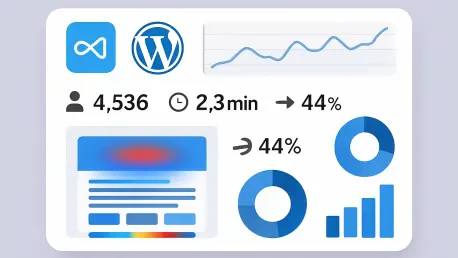In a digital landscape where website performance can make or break a business, the challenge of integrating powerful analytics tools often deters many WordPress users from gaining critical insights into user behavior, especially when WordPress powers an impressive 43% of all websites globally—equating to over 810 million sites. The need for accessible, user-friendly analytics solutions has never been more pressing. Microsoft has stepped up to address this gap with a significant update to its Clarity plugin, announced on July 30, 2025. This free behavioral analytics tool now offers seamless integration that eliminates previous setup hurdles, allowing website owners to dive into data like session recordings and heatmaps without ever leaving their WordPress dashboard. This development marks a pivotal shift for small business owners, developers, and digital marketers who seek enterprise-level insights without the complexity or cost typically associated with such tools.
1. Unveiling Key Enhancements to the Clarity Plugin
The latest update to the Microsoft Clarity plugin introduces a suite of features designed to simplify the analytics experience for WordPress users. One of the standout improvements is the automatic project creation, which instantly generates a new Clarity project upon plugin activation using the site’s existing name and URL. This eliminates the tedious process of manual form completion, a barrier that previously frustrated many users. Additionally, the plugin now offers instant setup redirection, guiding users directly to the Clarity setup screen within the WordPress environment. This ensures a smooth workflow without the need to juggle multiple platforms or disrupt productivity, making analytics integration feel like a natural extension of the WordPress interface.
Beyond setup automation, the plugin brings enhanced authentication and connectivity options to the table. Users can now sign in using Microsoft, Google, or Facebook accounts directly within the WordPress dashboard, avoiding the hassle of opening additional browser tabs. For those already using Clarity, a smarter project linking feature via a dropdown menu allows seamless connection to existing projects. Perhaps most notably, the embedded dashboard delivers session recordings, heatmaps, and engagement metrics—like rage clicks and dead clicks—right into the WordPress admin panel. This means website owners can analyze user behavior patterns and make data-driven decisions without navigating to external sites, streamlining the entire process of website optimization.
2. Step-by-Step Guide to Installing the Clarity Plugin
Navigating the installation of the Microsoft Clarity plugin is now a straightforward process, thanks to the recent update. The first step involves downloading the plugin directly from the WordPress admin panel, a familiar action for most users of the platform. Once located in the plugin repository, activation is just a click away, setting the stage for immediate setup. After activation, users are automatically redirected to the Clarity setup page within the WordPress dashboard, maintaining continuity and eliminating the need for external navigation. This seamless transition ensures that even those with minimal technical expertise can proceed without confusion or delay.
Following redirection, the next steps focus on authentication and project setup. Users sign in using their preferred method—whether through Microsoft, Google, or Facebook accounts—without leaving the WordPress environment. The system then either creates a new project automatically or offers the option to link to an existing one via a convenient dropdown menu. Finally, immediate access to analytics is granted through the embedded dashboard, allowing users to explore behavioral insights like session duration and user engagement metrics right away. This six-step process, reduced from hours to minutes, addresses past complexities and empowers WordPress site owners to harness powerful analytics with minimal effort.
3. Exploring the Robust Features of Microsoft Clarity
Microsoft Clarity stands out in the analytics arena by offering a comprehensive suite of tools at no cost, a significant advantage for WordPress users managing budgets. The platform provides unlimited traffic analysis, session recordings, and heatmap generation, processing data from millions of websites worldwide. Key behavioral insights are captured, including mouse movements, clicks, and scroll patterns, with specialized features like rage click detection identifying frustrating user interactions. Dead click analysis further reveals non-functional elements, enabling site owners to address usability issues that could otherwise drive visitors away. This depth of data offers a clear window into user experience without the financial burden of subscription fees.
Complementing these capabilities are visual tools like heatmaps, which illustrate user engagement across click, scroll, and attention dimensions. Real-time metrics displayed in the embedded dashboard include active users, session duration, and geographic distribution, with filters for device type and traffic source adding granularity to the analysis. Privacy compliance is also prioritized, with adherence to GDPR, CCPA, and other regulations through data anonymization and export options. Integration with Google Analytics enhances the toolset, allowing correlation of behavioral data with traditional metrics without manual code insertion. These features collectively position Clarity as a versatile solution for optimizing user journeys on WordPress sites.
4. Positioning in a Competitive Analytics Market
In a market where WordPress dominates as the backbone of 43% of global websites, the strategic importance of tailored analytics integration cannot be overstated. Microsoft Clarity’s focus on this platform taps into a vast user base of over 810 million sites, ranging from personal blogs to complex e-commerce setups. Unlike competitors such as Hotjar, which often charge between $39 and $199 monthly for similar functionalities, Clarity delivers enterprise-level features like advanced segmentation and API access at no cost. This pricing model democratizes access to high-quality analytics, making it an attractive option for small businesses and individual site owners who might otherwise forego such tools due to budget constraints.
The competitive edge of Clarity lies in its emphasis on automation and ease of use, setting it apart from platforms like Google Analytics that may require more technical know-how for full utilization. By embedding analytics directly into the WordPress dashboard, the plugin minimizes the learning curve and reduces setup time significantly. This approach not only addresses previous deterrents for WordPress users but also positions Clarity as a formidable alternative in a crowded field. The ability to offer sophisticated insights without usage limitations or subscription requirements further strengthens its appeal, catering to a diverse range of digital marketers and developers seeking actionable data without added expenses.
5. Reflecting on Recent Milestones in Clarity’s Evolution
Looking back, Microsoft Clarity’s journey of innovation reveals a consistent commitment to enhancing user experience across platforms. The major update to the WordPress plugin on July 30 was a culmination of efforts to simplify analytics for a massive user base. Earlier milestones, such as the introduction of a trends feature with 30-day visual analytics on July 16, showcased a focus on data visualization. The visual redesign of the Clarity live extension on June 25 aimed at simplifying access, while the launch of the Flutter SDK on June 16 expanded cross-platform support for mobile app analytics. These updates reflect a broader strategy to address diverse needs within the digital ecosystem.
Additional advancements included the AI analytics bridge for developer tools on June 4 and the inaugural Ambassador Program for analytics experts on June 2, targeting digital marketing professionals. The integration of Google Ads data analysis on January 13 and AI-powered insights for ad campaigns on May 14 further demonstrated Clarity’s adaptability. Even earlier steps, like the Wix integration in December 2024 for 230 million users and a detailed comparison with Google Analytics 4 in May 2024, underscored a commitment to versatility and transparency. Each milestone built on the last, creating a robust toolset that evolved to meet the dynamic demands of website owners and marketers across various platforms.
6. Understanding Core Concepts Behind the Integration
Delving into the foundational elements of this update, WordPress emerges as a critical player, powering 43% of global websites with its open-source flexibility. This content management system supports everything from simple blogs to intricate e-commerce solutions, making it a prime target for analytics tools like Clarity. The plugin architecture of WordPress allows third-party enhancements without altering core files, exemplified by Clarity’s addition of sophisticated analytics through a straightforward installation. Similarly, the concept of an embedded dashboard revolutionizes workflows by consolidating data within the familiar WordPress interface, reducing the need to switch platforms and enhancing productivity for users of all skill levels.
Further clarifying the framework, Microsoft Clarity itself is defined as a free behavioral analytics platform focusing on visual insights through session recordings and heatmaps, distinct from traditional statistical tools. Setup automation addresses technical barriers by streamlining processes, while session recordings and heatmaps provide detailed and visual data for usability optimization. Integration ensures seamless operation within existing WordPress workflows, and broader automation principles balance simplicity with customization for advanced users. These concepts collectively underpin a solution that not only simplifies analytics adoption but also ensures compliance with privacy standards like GDPR, fostering trust and utility among a wide audience.
7. Looking Ahead to Analytics Empowerment
Reflecting on the strides made with the Microsoft Clarity WordPress plugin update, it’s clear that significant barriers to behavioral analytics adoption have been dismantled. The streamlined setup, embedded dashboard, and automated features rolled out by the Clarity team, under the guidance of Ryan Loftus, tackled complexities that once hindered WordPress site owners and digital marketers. Available globally through the WordPress admin panel, this update—announced on July 30—marked a turning point in making powerful insights accessible within a familiar environment, catering to a market representing 43% of websites worldwide.
Moving forward, website owners are encouraged to leverage this tool to uncover user behavior patterns and optimize their digital presence with minimal effort. Exploring the embedded dashboard to analyze real-time metrics and heatmaps can reveal actionable opportunities for improvement. For those integrating with other platforms like Google Analytics, combining datasets could offer a more holistic view of performance. As the analytics landscape continues to evolve, staying updated on Clarity’s ongoing enhancements will ensure users remain equipped to adapt and thrive in an increasingly data-driven digital world.









